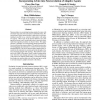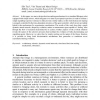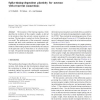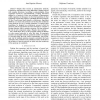130 search results - page 11 / 26 » Language networks: Their structure, function, and evolution |
AIIDE
2006
13 years 9 months ago
2006
Neuroevolution is a promising learning method in tasks with extremely large state and action spaces and hidden states. Recent advances allow neuroevolution to take place in real t...
CONNECTION
2004
13 years 7 months ago
2004
In this paper, we aim to design decision-making mechanisms for a simulated Khepera robot equipped with simple sensors, which integrates over time its perceptual experience in order...
BIBE
2006
IEEE
14 years 1 months ago
2006
IEEE
This paper discusses an ontology based language modeling text mining approach to the annotation of protein community. Communities appear to play an important role in the functional...
BC
2007
13 years 7 months ago
2007
The dynamics of the learning equation, which describes the evolution of the synaptic weights, is derived in the situation where the network contains recurrent connections. The deri...
CEC
2009
IEEE
14 years 2 months ago
2009
IEEE
— Despite their success as optimization methods, evolutionary algorithms face many difficulties to design artifacts with complex structures. According to paleontologists, living...




